- Bernard Preston homepage
- Bread
- Bread for Diabetics
Bread for diabetics
Bread for diabetics considers two factors; the overall carb load and the roundedness of our meals. Glycaemic starches lead directly to insulin resistance.
First it was animal fats that were condemned; butter was out and margarine was in. Then it was protein that came into doubt; now it's carbs. Perhaps even more than with clothing, fashion is something so bad that we have to change it every few years.
Before we delve into bread for diabetics let's have a short tour of the carbs; just what are they?
Bread for diabetics
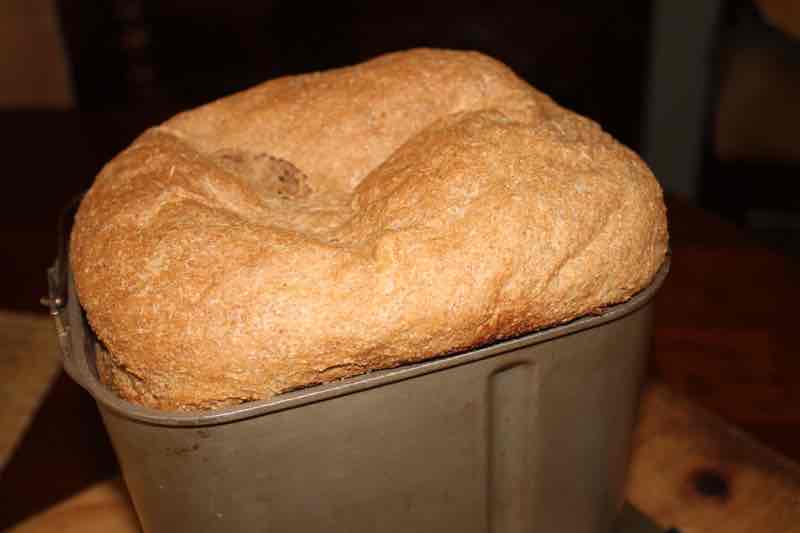
What are carbs?
Carbs consist of chains of glucose molecules that after being digested by amylase in the mouth and small intestine, are absorbed into the portal blood stream passing to the liver. There they are processed and either turned into glycogen for muscle energy or released directly into the serum; or converted into triglycerides and attached to protein molecules.
If those blood glucose levels shoot up too high or remain elevated, then you are diabetic. So everything is about slowing the release of these sugars from our food.
Simple and complex carbs
Very briefly simple carbs consist of one or two sugar units, known as
mono and disaccharides. Generally but there are exceptions, they are
broken down and assimilated very quickly. Diabetics should keep them to
an absolute minimum, period. Glucose and sucrose are two examples.
But how rapidly they are absorbed is completely dependent on the context of the whole meal. A cola on its own is highly glycaemic; for high and holy days only.
But if consumed with fat, protein and fibre these simple sugars, for example as a dessert are absorbed far more slowly.
What is resistant starch?
Complex carbs consist of three or more sugar units. They can be divided up into these categories.
- Rapidly digested starch is for example that found in a slice of chocolate cake and potatoes from cold storage. Diabetics for obvious reasons should avoid them entirely.
- Slowly digested starch would be that in 100% whole grains, new potatoes and legumes that have plenty of fibre.
- Resistant starch molecules pass on the whole through the small intestine with lesser amounts being absorbed. By far the greater part reaches the colon where they play an extremely important role in supplying the friendly bugs of the microbiome with nutrients. The pectin in fruit is an example.
This is an extremely complex subject. For example, cooling and reheating starches reduces their glycaemic index. Perhaps you could have vichyssoise that was cooked yesterday, refrigerated overnight and enjoyed for lunch; with added cream and chives.
Natural honey is made up of simple sugars; not heated and containing small amounts of pollen and many other micronutrients it has a low glycemic index. It's quite different to that found in grocery stores.
Bread flour
It remains a solid question demanding an answer; does refined bread flour constitute a food? After millers have removed most of the nutrients would a farmer feed it to his pigs? It will certainly fill a hole but how successfully does it satisfy our need for fibre, vitamins and phytonutrients?
One large bagel for breakfast and two slices of white bread for lunch amounts to seven servings of refined flour with a 47% greater risk of stroke, according to research in BMJ[1].
There's an opinion doing the rounds that there is no such thing as good and bad food. Up to a point I would agree; the context of the whole meal is vitally important.
A slice of bread for diabetics enjoyed with a high-fibre salad and cheese that would slow the emptying of the stomach contents and the production of glucose is quite different to a PB&J sandwich alone.
And the question remains too whether white rice should be considered a food. To their great cost, eating it themselves and feeding it to their chickens cost literally tens of millions of Indonesians their lives; they died from a B1 deficiency. The disease led to the first discovery of the first vitamin; thiamine.
A particularly astute Dutch medical doctor noted that the chickens belonging to the wealthy, who could afford to buy polished rice, died with the same symptoms as their owners.
Would a farmer feed super refined mealiemeal to his pigs or cattle? A serious horse breeder surely would only allow sugar cubes for treats on very rare occasions.
Disturbingly I think most of us would grudgingly admit that these highly refined carbs would not be given to animals. Yet we happily eat them ourselves and feed white bread, cornflakes and sugar to our children.
Bread for diabetics
And now back to bread for diabetics, having made the point that it's how quickly that slice raises your blood glucose that is critical.
- Bread made with highly refined all-purpose flour.
- Bread baked with what is today being called "whole grain" flour; more about that lower down.
- Bread baked with 100% flour with all three parts fully intact.
- Sourdough bread.
- Rye bread.
Clearly there is an enormous difference between these breads. Whether the bran, germ and endosperm are separated in the milling is critical.
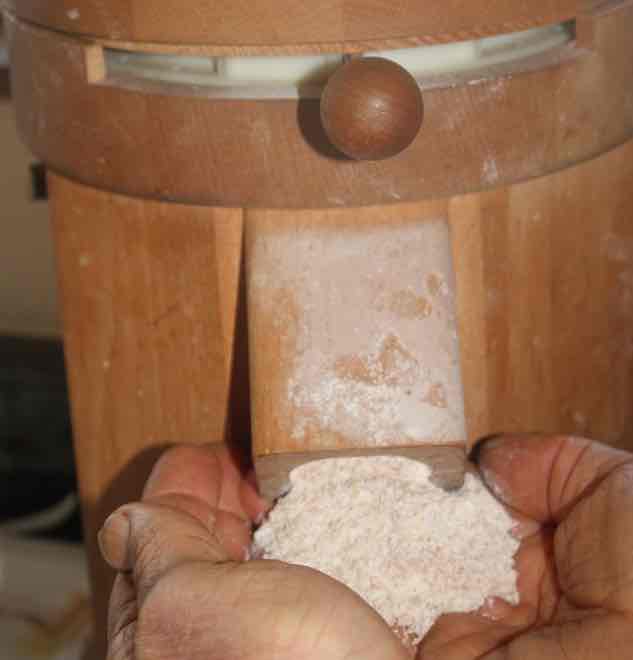 No separation of the three streams.
No separation of the three streams.Unstable diabetics and the morbidly obese
Let us report again what scientists reporting the in British Medical Journal have found.
Unstable diabetics with an A1c above 9 and the morbidly obese alas simply have to avoid all bread until their conditions are under control; otherwise blindness, kidney failure and a stroke are inevitable.
Even the very best sourdough bread made with 100% flour is strictly verboten; as are all starches. They simply have to get their carbs well below 50 grams per day.
Once the A1c is down below 7 and the BMI below 35 then half-slices of true wholegrain bread for diabetics in the context of a high fibre meal can be cautiously introduced. A continuous glucose monitor would immediately tell you what affect it is having.
100% wholemeal flour
Once the grain is cracked by grinding, oxygen reaches the fatty acids in flour; they immediately start going rancid. So millers remove them to improve the shelf-life.
Look for the 100% wholemeal sign; you won't find it very often. You may have to mill the wheat and bake the bread yourself.
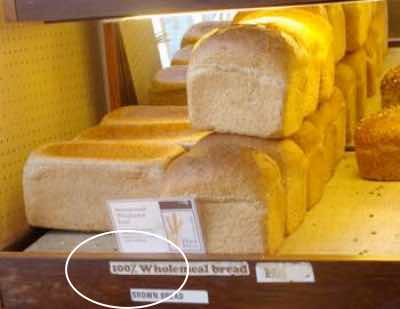
The big fat lie
“The simple step of a courageous individual is not to take part in the lie. One word of truth outweighs the world.”
Aleksandr Solzhenitsyn
By international law millers may label their flour "whole grain" provided they do not remove more than 40% of the goodies; in effect much of the bran and germ have been extracted[1].
"Whole grain" loaves made using this partly refined flour cannot be considered allowable bread for diabetics; it will still affect the blood glucose negatively. Each person must test themselves since we all react differently.
The context of the meal too is so important; a high fibre lunch of salads with plenty of olive oil slows the stomach emptying, perhaps making a slice of this so-called "wholegrain" bread acceptable. A finger prick test half an hour later will reveal the effect.
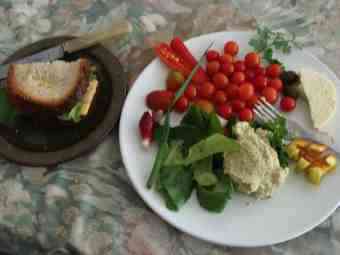 Cheese and lettuce sandwich with salad.
Cheese and lettuce sandwich with salad.Sourdough bread
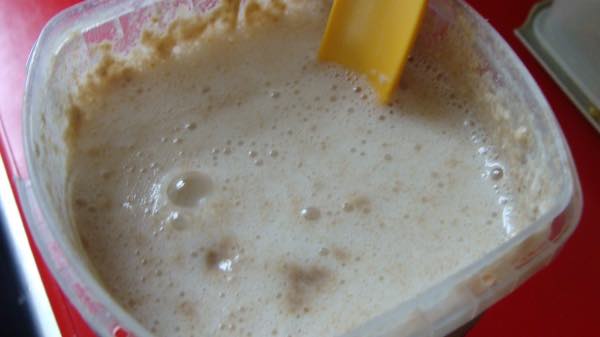
"Sourdough bread has a GI rating of 54 and a GL of 8; while a loaf made from white wheat flour has a glycemic index rating of 71 and a load of 9."
- Medical News today
Since these figures were almost certainly determined using sourdough bread baked with commercial "wholemeal" flour, we can expect that a loaf using 100% would be significantly lower still. I have been unable to find the figures but I expect the GI with all the bran and wheatgerm oil to be less than 50.
Bread for diabetics is allowed in moderation, if their blood glucose is stable; especially sourdough made with 100% flour but keeping the GL, or glycaemic load down.
So to summarise bread for diabetics
Stable diabetics with an A1c below 7 may be able to enjoy half or even one slice of sourdough bread baked with true 100% wholemeal flour; in the context of a high fibre meal with extra protein and fat.
Olive oil and avocados are the go-to fats of choice.
Following the meal with a short brisk walk of say ten minutes would help ameliorate any rise in blood glucose.
Whole grains and legumes are encouraged despite their carbohydrate content; they have so many other proven virtues. But do keep portion sizes small and monitor your blood glucose.
As a general rule all diabetics should avoid refined carbs, potatoes from cold storage and sugar. The damage by so-called AGEs to the eyes, kidneys and the blood vessels is all because of the inflammation that they cause.
So true 100% wholemeal sourdough bread is one of our 10 top anti-inflammatory foods.
It really is one of the "very good" foods; but very hard to find even in good bakeries. If you are serious about your health buy a mill and a bread machine; and get started.
If you bake daily the savings will pay off your investment in about a year; sourdough bread is very expensive.
"Do not eat any refined-carbs, period."
Dr Atkins
Insulin medication for diabetes
There is disturbing evidence that one of the serious side effects of both insulin and antihypertensive medication is pancreatitis; which in turn increases the likelihood of the most serious cancer.
Only 13% of those diagnosed with pancreatic cancer survive 5 years. Taking seriously the need for only wholegrain bread for diabetics is not small beer; those who are obese frequently need both hypertensive drugs and insulin. Dr Atkins got it exactly right. "Do not eat any refined carbs, period."
When browsing use right click and "Open Link in New Tab" or you may get a bad gateway signal.
Newsletter
Our newsletter is entitled "create a cyan zone" at your home, preserving both yourself and Mother Earth for future generations; and the family too, of course. We promise not to spam you with daily emails promoting various products. You may get an occasional nudge to buy one of my books.
Here are the back issues.
- Lifestyle and ideal body weight
- What are ultra-processed foods?
- Investing in long-term health
- Diseases from plastic exposure
- Intensive lifestyle management for obesity has limited value
- A world largely devoid of Parkinson's Disease
- The impact of friendly bacteria in the tum on the prevention of cancer
- There's a hole in the bucket
- Everyone is talking about weight loss drugs
- Pull the sweet tooth
- If you suffer from heartburn plant a susu
- Refined maize meal and stunting
- Should agriculture and industry get priority for water and electricity?
- Nature is calling
- Mill your own flour
- Bake your own sourdough bread
- Microplastics from our water
- Alternative types of water storage
- Wear your clothes out
- Comfort foods
- Create a bee-friendly environment
- Go to bed slightly hungry
- Keep bees
- Blue zone folk are religious
- Reduce plastic waste
- Family is important
- What can go in compost?
- Grow broad beans for longevity
- Harvest and store sunshine
- Blue zone exercise
- Harvest and store your rainwater
- Create a cyan zone at your home
Did you find this page interesting? How about forwarding it to a friendly book or food junkie? Better still, a social media tick would help.
- Bernard Preston homepage
- Bread
- Bread for Diabetics
Address:
56 Groenekloof Rd,
Hilton, KZN
South Africa
Website:
https://www.bernard-preston.com